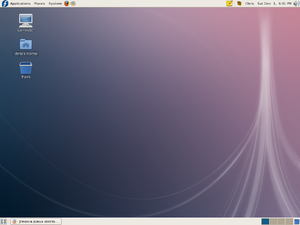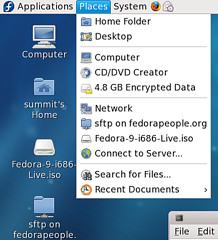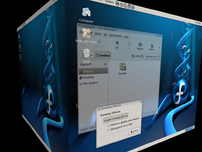It is time to talk about our Fedora 11 server migration. Why, do you ask, are we discussing this three months after Fedora 11 was released, halfway to the release of Fedora 12?
We finally upgraded our server to Fedora 11 this morning, after a weekend of work. In previous generations, we’d offloaded all of the data, formatted all the drives, and installed the new OS. And we, to keep up, would have to do this every 6-9 months, every time a new Fedora release came out. And our data kept growing. When you are storing many gigabytes of information, trying to slowly offload to a 4.3GB DVD is a slow process.
This weekend, we threw in the metaphorical towel, and got a 1.5TB drive and installed it in the computer. This allowed us to empty our older drives one by one and reformat them to EXT4 format. We had previously been using the more established XFS format. EXT4 is an update of the established EXT3 with improved handling for large files, among other things.
Improved large file handling is very important to us, because we use our server as a storage base for our MythTV DVR. Large file handling is required when an hour of over-the-air broadcast HD can be more than 8GB.
After reformatting all the drive to EXT4, we discovered another feature we’d never noticed before. The Reserved Block Percentage for the Superuser. A default setting, it holds back 5% of the reported available drive space for superuser privileged processes, ensuring that even if the hard drive fills up, the running processes can still do their work. Which is all well and good on an OS partition. But on a data partition, 5% of a TB drive is almost 50GB being held in reserve. Ultimately, now that we know it is there, we left it turned it. You can override it as needed.
While we kept all the data on the data drives, although we did move around what was stored where, we did wipe and redo the OS partition completely. This is always a learning experience because as we rebuild parts of it, we add and fiddle with features, some of which are new to the upgraded OS. For example, we added an hourly run of status information which is ported to Linux’s MOTD(Message of the Day) feature so that anyone logging in receives a notification of them.
We also tried running tuned. Tuned isn’t enabled by default under Fedora 11, and it is merely an early version of a project that should be fully realized in Fedora 12. For several versions, Fedora has been auditing programs to look for redundancy or inefficiency. One of the most solid examples of that was a goal of a 20-second boot time. There is an apparent lack of good discourse on tuned that we found, but the service will allow cpu, disk, and net devices to adapt dynamically to usage, reducing power, according to profiles set.
Tuned, unfortunately, kept bringing down our network link, causing hiccups. For now, we’ve turned it off. Power Management is a goal we aspire to. We want constant availability with low power usage, which means a service that turns things off when not in use. We look forward to the next generation of this program, when it may be enabled by default.
Since our server does not run a graphical environment by default, nor does it have a monitor attached normally, the experience of using it is different than most using a Linux machine. We’re always looking for things to cut from it to improve its efficiency. During this latest iteration, we cut a partition, no longer creating a separate home partition for the system. We never store anything in the home directories anyway.
You will be hearing more about our server. Our systems are the testbed for practical experiments in spinning down hard drives and other techniques to try and reduce waste. The drives are even 5400rpm ‘green’ drives, as the data doesn’t require anything faster. If you are interested in more specific details about the system, comment. We’d love to hear your feedback.




![Reblog this post [with Zemanta]](http://img.zemanta.com/reblog_e.png?x-id=70fd40fc-bd93-474b-beca-9f1c5afc3061)
![Reblog this post [with Zemanta]](http://img.zemanta.com/reblog_e.png?x-id=08b345df-eba7-4383-9e84-f702ddc55f23)


![Reblog this post [with Zemanta]](http://img.zemanta.com/reblog_e.png?x-id=5bb0bc46-6cd6-48a7-8d5d-ea2b32592c64)


![Reblog this post [with Zemanta]](http://img.zemanta.com/reblog_e.png?x-id=bbccdbe4-582e-4e5a-9e02-dd017945e782)


![Reblog this post [with Zemanta]](http://img.zemanta.com/reblog_e.png?x-id=bf7edfec-3be4-433b-a588-9b6e6d13f943)

![Reblog this post [with Zemanta]](http://img.zemanta.com/reblog_e.png?x-id=36b1052e-27ed-49e1-913c-d6f9c005fe4f)
![Reblog this post [with Zemanta]](http://img.zemanta.com/reblog_e.png?x-id=64de604d-d1dc-48e1-aa7b-80156409e4d2)
![Reblog this post [with Zemanta]](http://img.zemanta.com/reblog_e.png?x-id=66e04412-d5d4-4e4c-8b45-60330c6f62c6)